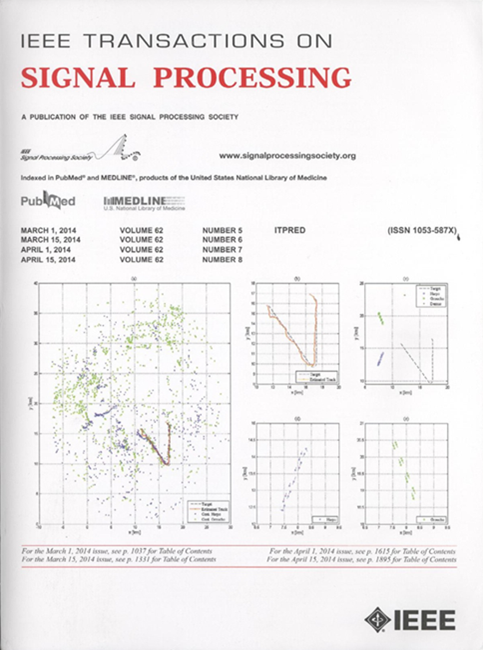通过标记随机有限集进行多目标估计概述
IF 4.6
2区 工程技术
Q1 ENGINEERING, ELECTRICAL & ELECTRONIC
引用次数: 0
摘要
本文介绍了多目标系统的标签随机有限集(LRFS)框架--在该框架中,目标的数量及其状态是未知的,并且随时间随机变化。我们特别关注通过多目标状态空间模型(SSM)进行状态和轨迹估计,该模型允许原则性可控的多目标跟踪滤波器/平滑器。与单目标模型不同,状态时序并不一定代表多目标系统的轨迹。而 LRFS 方案则能用多目标状态的时间序列来表示多目标轨迹,并考虑到轨迹交叉和碎裂。我们介绍了 LRFS 的基本原理,包括一系列常用模型和数学装置(包括未在其他地方发表的最新成果)。在此基础上,我们概述了使用 LRFS 进行多物体状态空间建模和估算的基本原理,正式论述了物体身份/轨迹、生成物体的祖先,以及物体集合(及其轨迹)的不确定性特征。多对象 SSM 问题的数值解决方案本质上比标准 SSM 更具挑战性。为了缩小理论与实践之间的差距,我们讨论了最先进的实现方法,这些方法解决了物体、测量、传感器和扫描数量方面的关键计算瓶颈。本文章由计算机程序翻译,如有差异,请以英文原文为准。
An Overview of Multi-Object Estimation via Labeled Random Finite Set
This article presents the Labeled Random Finite Set (LRFS) framework for multi-object systems–systems in which the number of objects and their states are unknown and vary randomly with time. In particular, we focus on state and trajectory estimation via a multi-object State Space Model (SSM) that admits principled tractable multi-object tracking filters/smoothers. Unlike the single-object counterpart, a time sequence of states does not necessarily represent the trajectory of a multi-object system. The LRFS formulation enables a time sequence of multi-object states to represent the multi-object trajectory that accommodates trajectory crossings and fragmentations. We present the basics of LRFS, covering a suite of commonly used models and mathematical apparatus (including the latest results not published elsewhere). Building on this, we outline the fundamentals of multi-object state space modeling and estimation using LRFS, which formally address object identities/trajectories, ancestries for spawning objects, and characterization of the uncertainty on the ensemble of objects (and their trajectories). Numerical solutions to multi-object SSM problems are inherently far more challenging than those in standard SSM. To bridge the gap between theory and practice, we discuss state-of-the-art implementations that address key computational bottlenecks in the number of objects, measurements, sensors, and scans.
求助全文
通过发布文献求助,成功后即可免费获取论文全文。
去求助
来源期刊

IEEE Transactions on Signal Processing
工程技术-工程:电子与电气
CiteScore
11.20
自引率
9.30%
发文量
310
审稿时长
3.0 months
期刊介绍:
The IEEE Transactions on Signal Processing covers novel theory, algorithms, performance analyses and applications of techniques for the processing, understanding, learning, retrieval, mining, and extraction of information from signals. The term “signal” includes, among others, audio, video, speech, image, communication, geophysical, sonar, radar, medical and musical signals. Examples of topics of interest include, but are not limited to, information processing and the theory and application of filtering, coding, transmitting, estimating, detecting, analyzing, recognizing, synthesizing, recording, and reproducing signals.
 求助内容:
求助内容: 应助结果提醒方式:
应助结果提醒方式:


